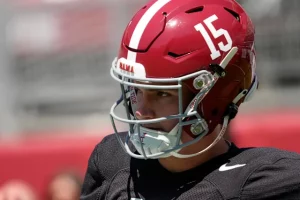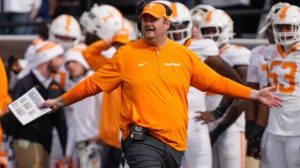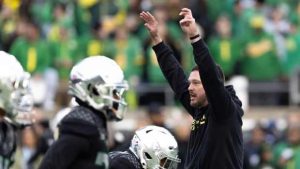
Branson Robinson, a running back for Georgia, logs into the NCAA Transfer Portal
Branson Robinson, a talented running back for the University of Georgia Bulldogs, has recently made the decision to enter the NCAA Transfer Portal. This marks a significant point in his college football career, a choice that has raised eyebrows across the sport, as he is one of the most promising young talents in the country. The decision to leave a powerhouse program like Georgia, a team that has consistently contended for national championships, is one that reflects both the complexity of modern college football and the shifting dynamics of player mobility.
In this article, we will explore what this move means for Branson Robinson, the broader implications of his decision, and what it tells us about the changing nature of college football as a whole.
Branson Robinson’s Background
Before diving into the impact of his decision to transfer, it’s important to understand who Branson Robinson is and why his departure from Georgia is such a noteworthy event. Robinson was a five-star recruit coming out of Germantown High School in Madison, Mississippi. He was one of the most highly sought-after running back prospects in the country, drawing comparisons to some of the best backs to ever come through the college ranks. At 5’10” and 225 pounds, Robinson possesses the perfect blend of power, speed, and agility that makes him a coveted asset for any program.
At Georgia, Robinson joined a running back room that had no shortage of talent. From the beginning, it was clear that he had the potential to be a centerpiece of the offense. However, as with many programs at the highest level of college football, the competition for playing time is fierce, and Georgia’s running back corps has been loaded with talent. In Robinson’s time with the Bulldogs, he has seen limited action behind other talented backs, including the likes of Kendall Milton, Daijun Edwards, and former standout James Cook, who was drafted by the Buffalo Bills in the 2022 NFL Draft.
Despite the depth at Georgia, Robinson’s potential was still undeniable. His powerful running style, combined with his ability to break tackles and accelerate through holes, made him an exciting player to watch. However, the crowded backfield at Georgia meant that Robinson’s opportunities to showcase his skills in meaningful game situations were often limited. This, in part, might have contributed to his decision to explore other options through the Transfer Portal.
The NCAA Transfer Portal: An Overview
The NCAA Transfer Portal was introduced in 2018 and has radically altered the landscape of college athletics. Before its implementation, student-athletes who wanted to transfer between schools had to receive permission from their current institutions, and the process was often cumbersome and filled with red tape. The Transfer Portal gave players more control over their future by allowing them to enter their names into a system, where they could explore transfer options freely.
In the past few years, the Transfer Portal has become an increasingly important tool for players to find new opportunities. For some, it represents a fresh start or a chance to move to a program that offers more playing time, while for others, it’s an opportunity to compete at a higher level or in a different system. For Branson Robinson, entering the portal likely reflects a desire to play a more significant role in a program where he can be a focal point of the offense.
Why Did Branson Robinson Enter the Transfer Portal?
Several factors likely played into Branson Robinson’s decision to enter the Transfer Portal, and each one provides insight into the modern-day challenges facing college football players.
1. Playing Time and Opportunity
One of the most common reasons players choose to transfer is to seek more playing time. As previously mentioned, Georgia’s running back room has been stacked with talent, and despite his impressive skill set, Robinson found himself behind established players on the depth chart. While Georgia’s offense has been highly successful, the competition for carries in the backfield has been stiff. For a player with Robinson’s potential, the desire to see more action and have a more significant impact on the field is a compelling reason to explore a transfer.
For Robinson, the decision may have been influenced by the presence of other star running backs, some of whom may be returning for additional years. With many players sticking around longer than before due to the extra eligibility granted during the COVID-19 pandemic, it’s possible that Robinson realized his chances to be the lead back at Georgia were limited in the near future.
2. NFL Aspirations
Another factor that could have influenced Robinson’s decision is his professional aspirations. As one of the top running back prospects in the country, Robinson has aspirations of playing at the next level in the NFL. While Georgia’s program is a perennial powerhouse and has produced numerous NFL-caliber players, being a star at Georgia does not guarantee a high draft pick in the NFL. The college game has become more and more focused on the passing game, which can sometimes limit the opportunities for running backs to showcase their talents.
By transferring to a program where he would be the centerpiece of the offense, Robinson would likely have a better chance to display his skills and improve his draft stock. A school with a more run-heavy offense or a team that needs an immediate impact player at running back could provide the opportunity Robinson needs to showcase his talents.
3. Coaching and System Fit
In addition to playing time and professional aspirations, the fit within a program’s system and coaching staff plays a crucial role in a player’s decision to transfer. While Georgia’s offensive system is highly successful, it’s possible that Robinson felt he could thrive in a different scheme that better suits his running style. Every running back has a unique set of strengths, and some may fit better in certain offenses than others. For Robinson, the opportunity to play in a system that plays to his strengths could be an appealing reason to seek a new home.
4. The Transfer Portal Era
In today’s era of college football, the Transfer Portal has become an increasingly normalized aspect of the sport. Players are more empowered than ever before to make moves based on their personal and professional goals. This is especially true for players like Robinson, who have the talent to make an immediate impact at other programs. The culture surrounding transfers has changed, and many players no longer feel confined to the decision they made when first committing to a school.
By entering the Transfer Portal, Robinson is taking advantage of the opportunities available to him, choosing to take control of his future rather than remain in a situation that may not fully align with his goals.
What Are the Potential Landing Spots for Robinson?
Now that Branson Robinson has entered the Transfer Portal, the next question is where he might land. The Transfer Portal has become an open market for talent, with programs around the country constantly looking to improve their rosters. Given Robinson’s skill set, there will likely be a strong demand for his services.
Several schools could be attractive options for Robinson:
1. Alabama
Alabama is another powerhouse program with a storied history of producing top-tier running backs. The Crimson Tide is often in the market for a standout running back, and Robinson’s physicality and playmaking ability could make him a great fit in their system. With Alabama’s tradition of competing for national championships, Robinson could thrive in a high-powered offense that is centered around a strong rushing attack.
2. Michigan
Michigan is another program that could be an ideal fit for Robinson. The Wolverines run a balanced offensive system that values a strong running game, and Robinson’s physicality would mesh well with their power-running style. Under head coach Jim Harbaugh, Michigan has developed a strong culture and has been competitive in the Big Ten and national title races.
3. LSU
LSU is known for its strong recruiting and its ability to develop running backs who excel at the collegiate and professional levels. The Tigers have had success with power backs in the past, and Robinson’s skill set could make him a standout in Baton Rouge. With the right coaching and a solid offensive line, Robinson could quickly become one of the focal points of LSU’s offense.
4. USC
USC, a team with a high-flying offense and a tradition of excellence, could be an intriguing option for Robinson. Though USC tends to focus on passing the ball, the program has shown interest in developing a balanced offensive attack. Robinson’s physicality could provide USC with a dynamic running back who can contribute both as a ball carrier and in the passing game.
The Changing Landscape of College Football
Branson Robinson’s decision to enter the Transfer Portal is a reflection of the broader changes taking place in college football. The introduction of the Transfer Portal, combined with the NIL (Name, Image, and Likeness) rights, has fundamentally altered how players approach their college careers. No longer are athletes locked into their initial decisions; they now have the freedom to move between schools, seeking the best opportunities for both their athletic and personal development.
As the Transfer Portal continues to evolve, more and more players are taking advantage of this new freedom to explore different opportunities. This shift is both exciting and challenging for college football, as programs must now contend with an ever-changing roster landscape. For players like Branson Robinson, the Transfer Portal offers the chance to find the right fit for their talents, and his decision to enter it is just the latest chapter in the ongoing evolution of college sports.
Branson Robinson’s decision to enter the NCAA Transfer Portal is a significant moment in his career and in the broader context of college football. It represents the growing influence of player empowerment and the changing dynamics of roster construction in college programs. For Robinson, the move is likely motivated by a desire for more playing time, a stronger chance at reaching his NFL dreams, and the chance to fit into an offense that better suits his strengths. While it’s unclear where he will end up, it’s certain that his next stop will be one where he can thrive and take his game to the next level.
As the landscape of college football continues to shift with the increasing prevalence of transfers and the rise of NIL, Robinson’s journey serves as a window into the future of the sport. For players like him, the sky is the limit, and the Transfer Portal is one of the tools that allows them to make the most of their college careers.





